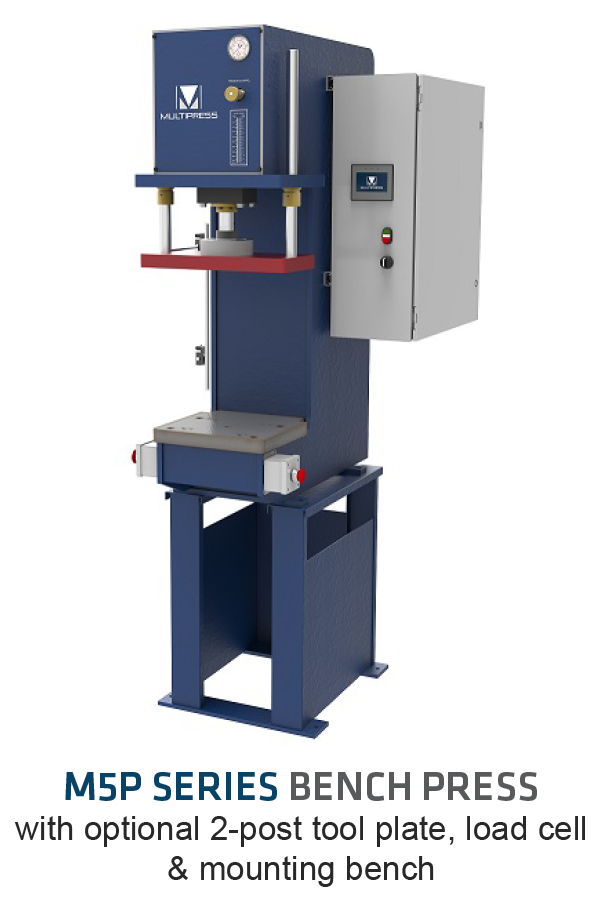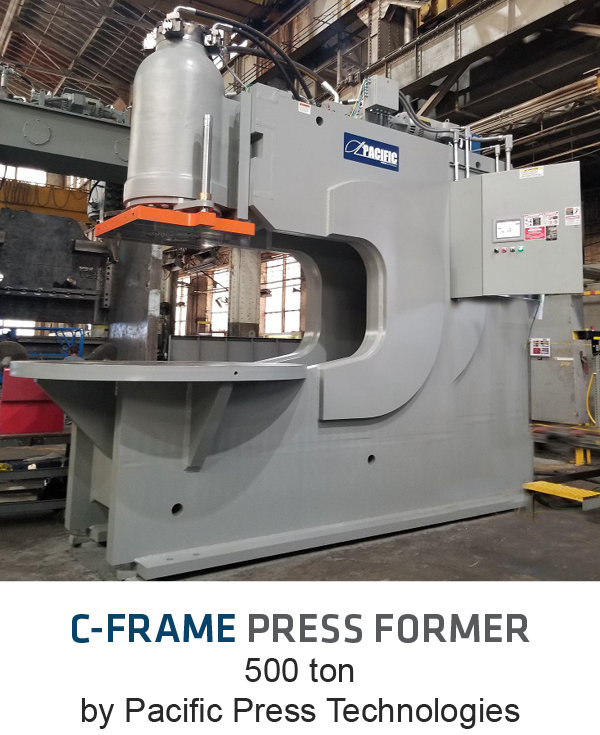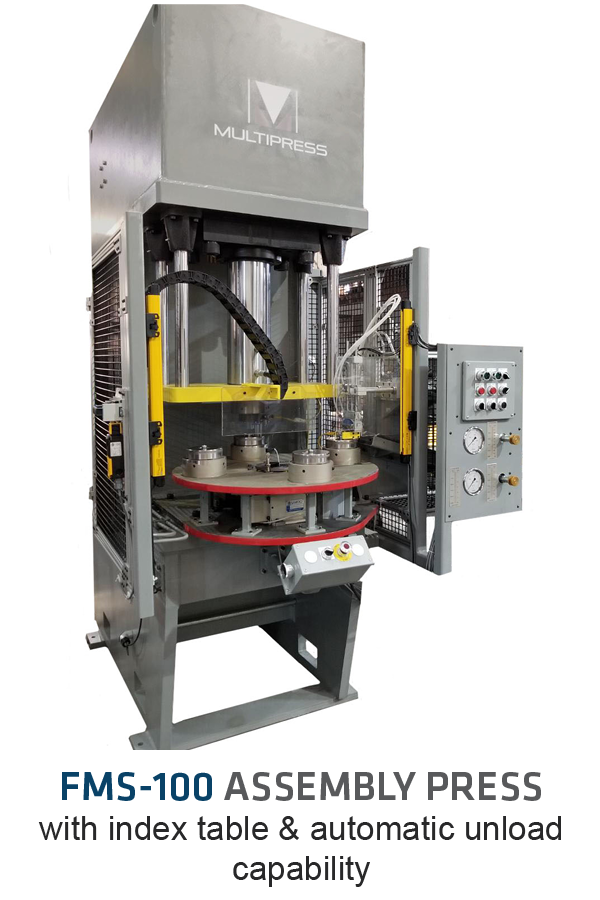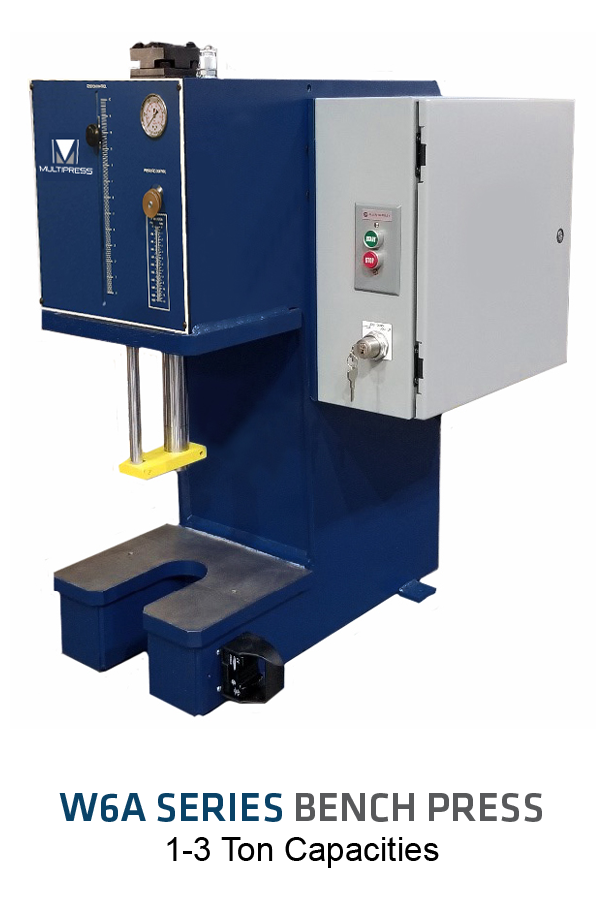Overview of the C-Frame Press: Benefits & Common Applications
C-frame presses are a commonly used type of hydraulic press. These presses get their name from the fact that the press itself is shaped like the letter “C”, however the press may be referred to by other names such as “gap-frame press”. C-frame presses are designed to take up less floor space than other metalworking machinery, while still providing great utility and minimal stroke deflection. Just like other hydraulic presses, C-frame presses are extremely versatile and can be used for many applications across several different industries.
C-Frame Press Design
 While there may be some variations in C-frame press design, the general design consists of steel framework, hydraulic cylinder, and upper and lower platens. These are otherwise known as the slide table and the bolster table. The frame of the press is generally made from A36 steel because of its favorable characteristics and strength and makes our hydraulic C-frame presses suitable for stamping applications.
While there may be some variations in C-frame press design, the general design consists of steel framework, hydraulic cylinder, and upper and lower platens. These are otherwise known as the slide table and the bolster table. The frame of the press is generally made from A36 steel because of its favorable characteristics and strength and makes our hydraulic C-frame presses suitable for stamping applications.
With the C-frame’s three open sides, the press can easily handle a variety of applications that include many material shapes and sizes. C-frame presses are often relied upon for applications that require smaller bed sizes and lower tonnages – although there are some exceptions. MULTIPRESS’ sister company, Pacific Press, for example has built C-frame presses with more than 750 tons of pressure for special applications.
While there can be design variations, all MULTIPRESS machines are designed to operate either manually OR automatically, to allow for the option of short run, or high volume production. In general, C-frame presses can also be fitted with a variety of different tooling to allow for bending, punching, cutting or straightening applications.
Benefits of a C-Frame Press
In addition to the open space made inherently available by its design, and the option to operate manually or automatically, C-frame presses offer manufacturers a variety of other benefits, including:
- Minimal floor space: C-Frame presses generally take up less floor space than most other hydraulic presses (such as 4-post presses) due to their narrow and sturdy C-shaped frame.
- Ease of use & efficiency: The press’ design provides minimal stroke deflection, work accessibility, increased open area, and work approach advantages.
- Access points: With three access points to the operations area, C-frame presses allow for easier die maintenance and adjustments, along with removal of scrap metal and finished parts.
- Cost effective: This press style is generally lower in cost as compared to other hydraulic press types.
Common Applications of a C-Frame Press
As mentioned, C-frame presses can accommodate a variety of applications. One of the more common  applications is stamping. During the stamping process, stamped parts from the C-frame press are formed using a sheet metal such as copper, titanium, stainless steel, or aluminum. A press tool, referred to as a die, is used to shape the parts from the inserted sheet metal. The ram then pushes the sheet metal through the die creating the required shape.
applications is stamping. During the stamping process, stamped parts from the C-frame press are formed using a sheet metal such as copper, titanium, stainless steel, or aluminum. A press tool, referred to as a die, is used to shape the parts from the inserted sheet metal. The ram then pushes the sheet metal through the die creating the required shape.
Besides stamping, manufacturers may also perform other metal forming processes, such as:
- Assembly: Fastening two or more parts together with a hydraulic assembly press.
- Bending: Straining material, usually flat sheet or strip metal, by moving it around a straight axis and applying stress. The bend is permanently set after removal of the applied stress.
- Blanking: Cutting out a piece of metal and then retaining that piece of metal. The rest of the material is discarded as scrap.
- Coining: Highly compressing all surfaces of a workpiece within a closed-die system.
- Compaction: An object produced by the compression of powdered material, typically done with a custom hydraulic compaction press.

- Crimping: An assembly technique that uses a custom assembly press and appropriate tool to fold and flatten material so that two pieces are securely fastened together by pinching action. This technique is commonly used to join sheet metal parts.
- Draw and deep draw work: Pulling metal through a tapered die and stretching the metal into a thinner shape.
- Embossing: A process using a custom hydraulic press that creates imprinted designs in sheet material by means of male and female dies, theoretically with no change in metal thickness.
- Forming: Converting a flat sheet metal workpiece into a 3-D part.
- Piercing: Cutting or punching an opening, such as a hole in sheet material, plate or various parts with a hydraulic C-frame floor press.
- Press fitting: Assembling parts with an interference fit.
- Staking: A method using a custom assembly press to permanently fasten two pieces of parts together by recessing one piece within the other and causing plastic flow of the material at the joint.
- Straightening: Bending, twisting, or stretching to correct any deviation from straightness in bars, tubes, or similar long parts or shapes.
- Trimming: Typically, a secondary cutting or shearing operation on a previously formed, drawn or forged part. The goal is to “trim” any surplus metal off the edges, bringing the part to the desired shape and size.
Among the most common hydraulic press applications for MULTIPRESS are assembly, stamping and trimming.
Some of the industries that commonly rely on C-frame hydraulic presses include aerospace manufacturing, appliance, automotive manufacturing, ceramics, food and beverage processing, industrial, marine, medical, military and defense, packaging, and pulp and paper.
Advantages of a MULTIPRESS C-Frame Press
At MULTIPRESS, our press expertise and flexibility allow us to manufacture and customize C-frame press machines to meet your fabrication and production needs. The advantages of a MULTIPRESS C-frame hydraulic press surpass the competition. When you invest in a MULTIPRESS, you gain:
press machines to meet your fabrication and production needs. The advantages of a MULTIPRESS C-frame hydraulic press surpass the competition. When you invest in a MULTIPRESS, you gain:
Reliability: MULTIPRESS equipment is always built with our signature rugged, heavy duty construction, designed to meet demanding production schedules with years of trouble-free operation.
Versatility: MULTIPRESS designs and builds C-frame hydraulic presses to accommodate many sizes for a wide variety of applications. MULTIPRESS C-frame presses can be used for applications ranging from 20-200 tons. We offer two distinctive series of C-frame hydraulic press machines: The C-frame floor model press series and the C-frame bench press series. Each series is uniquely designed to meet our customer’s production requirements.
Customized Design: MULTIPRESS routinely builds customized models based on individual client application and production requirements. We offer bench top versions of the C-frame hydraulic press including the W6A and M5P models, in addition to the larger floor models within our FMS series. Our experienced engineering staff partners closely with clients to ensure each press is built to the required specifications.
There are many options or add-ons available when designing the right C-frame press for your application. MULTIPRESS C-frame press customizable options include, but not limited to:
- stroke, daylight, load cells, adjustable pressing speed, additional daylight, stroke, or throat, 2 and 4 post tool plates, flanged fused disconnect, limit switch reversal, data acquisition and reporting, recipe storage, t-slots, die lifters, die clamps, dowel holes, slug holes, moving platens, die cushions, ejectors, index table (2,3,4,6,8,12 stop and servo), shuttle tables (manual and powered), and conveyors and pick & place.
To set yourself apart in a competitive industry, contact our sales team today to get started. Email us at sales@multipress.com or call 877.264.9611. Learn more about MULTIPRESS at www.multipress.com.


